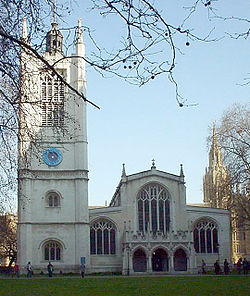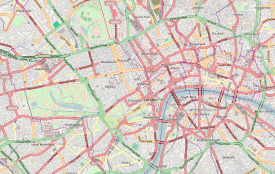St. Margaret's Church, Westminster
| St Margaret's, Westminster Abbey | |
|---|---|

St Margaret's Church, Westminster Abbey. The Central Tower of the Palace of Westminster is in the background.
|
|
| Location | City of Westminster, London, UK |
| Coordinates | 51°30′00″N 00°07′37″W / 51.50000°N 0.12694°WCoordinates: 51°30′00″N 00°07′37″W / 51.50000°N 0.12694°W |
| Founded | 12th Century |
| Rebuilt | 1486 to 1523 |
| Official name: Palace of Westminster, Westminster Abbey and Saint Margaret's Church | |
| Type | Cultural |
| Criteria | i, ii, iv |
| Designated | 1987 (11th session) |
| Reference no. | 426 |
| Country | United Kingdom |
| Region | Europe and North America |
The Church of St Margaret, Westminster Abbey, is situated in the grounds of Westminster Abbey on Parliament Square, and is the Anglican parish church of the House of Commons of the United Kingdom in London. It is dedicated to Margaret of Antioch.
Originally founded in the twelfth century by Benedictine monks, so that local people who lived in the area around the Abbey could worship separately at their own simpler parish church, and historically part of the hundred of Ossulstone in the county of Middlesex, St Margaret's was rebuilt from 1486 to 1523. It became the parish church of the Palace of Westminster in 1614, when the Puritans of the seventeenth century, unhappy with the highly liturgical Abbey, chose to hold Parliamentary services in the more "suitable" St Margaret's: a practice that has continued since that time.
The Rector of St Margaret's is a canon of Westminster Abbey.
The north-west tower was rebuilt by John James from 1734 to 1738; at the same time, the whole structure was encased in Portland stone. Both the eastern and the western porch were added later by J. L. Pearson. The church's interior was greatly restored and altered to its current appearance by Sir George Gilbert Scott in 1877, although many of the Tudor features were retained.
Notable features include the east window of 1509 of Flemish stained glass, created to commemorate the betrothal of Catherine of Aragon to Henry VIII. Other windows commemorate William Caxton, Britain's first printer, who was buried at the church in 1491, Sir Walter Raleigh, executed in Old Palace Yard and then also buried in the church in 1618, the poet John Milton, a parishioner of the church, and Admiral Robert Blake. The collector Henry Constantine Jennings is also buried there.
...
Wikipedia

